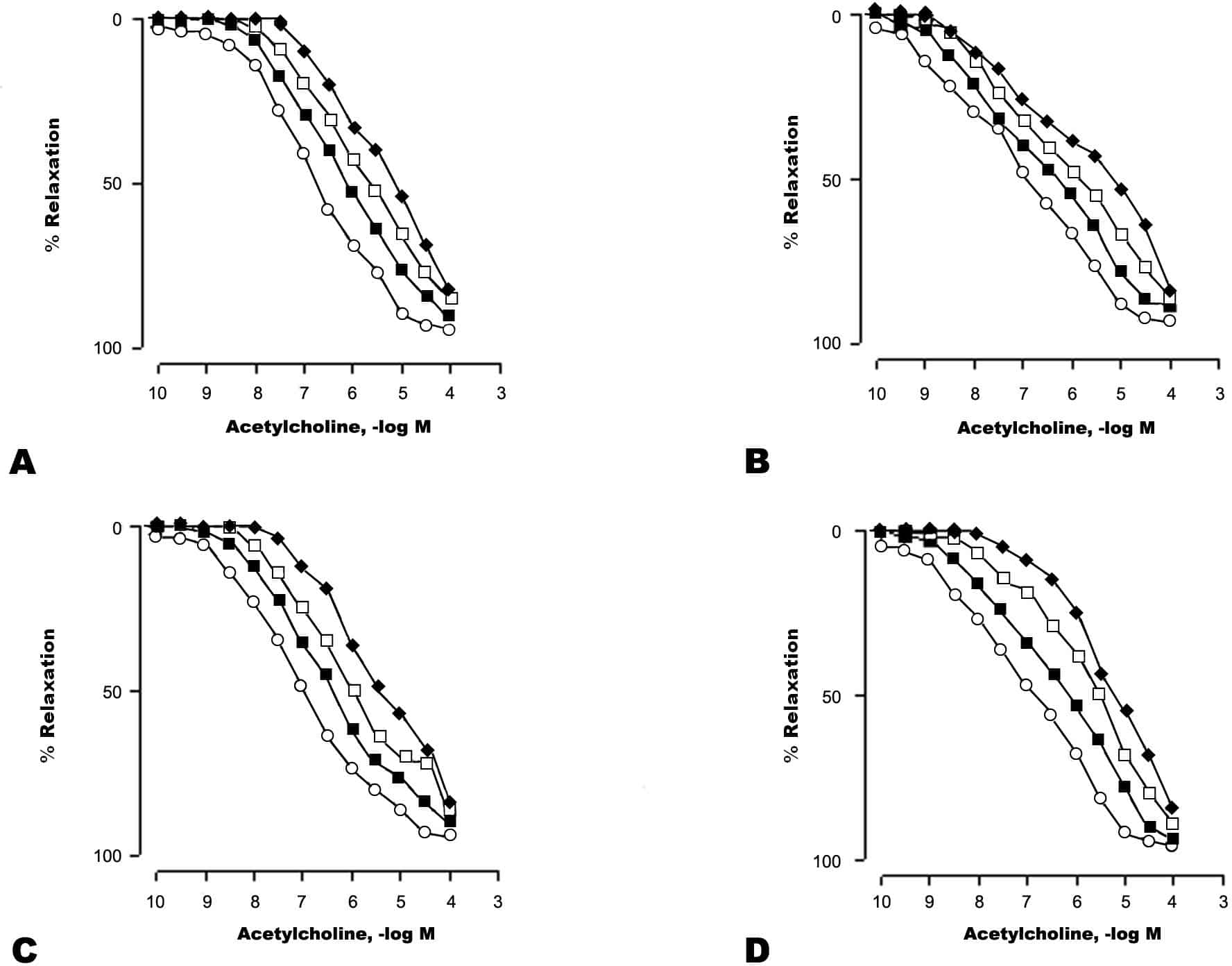Vascular tone of canine uterine artery is mainly dependent on neurogenic impacts and functional integrity of its endothelium (Okamura et al., 1995; Pesic et al., 2003). Acetylcholine modulates blood flow causing vasodilatation by releasing nitric oxyde through the activation of muscarinic receptors located on the endothelial cells (Ignarro et al., 1987, Tare et al., 1990). To identify the receptor subtype functionally involved in acetylcholine-induced relaxation in canine uterine artery, arterial segments were taken from healthy non-pregnant mixed breed adult female dogs which underwent ovariohysterectomy as a method of sterilization. All surgical procedures followed the animal welfare regulations. Premedication with atropine (0.02-0.04 mg/kg), acepromazine (0.02-0.04 mg/kg) and ketamine (15 mg/kg) given intravenously preceded general anesthesia with halothane, nitrous oxide and oxygen combined. A range of muscarinic receptor antagonists such as atropine (non-selective), pirenzepine (M1-selective), methoctramine (M2-selective) and p-fluoro-hexahydro-sila-difenidol (p-FHHSiD) (M1/M3) were used and their pA2 values were determined by Shild method. The relaxation of uterine arterial rings in response to acetylcholine in the presence or absence of selective muscarinic receptors antagonists was calculated using concentration response curves. Acetylcholine induced concentration-dependent and endothelium-dependent relaxation of arterial rings precontracted with phenylephrine (pEC50 = 6.90±0.02). The effects of competitive acetylcholine antagonists were concentration dependent and induced a significant rightward shift (p<0.05 for all antagonists tested, by Student t-test) of the concentration-response curves to acetylcholine (Fig.1). The Schild plot slopes for muscarinic receptor antagonists tested in this study yielded straight lines with mean slopes no different to unity indicating that the antagonism is competitive. Obtained pA2 values are given in Table 1. The present study has shown that canine uterine artery contains functional cholinergic muscarinic receptors that mediate acetylcholine relaxation which is endothelium-dependent and concentration-dependent. On the basis of differential antagonist affinity we propose that this relaxation is mediated predominantly by stimulation of muscarinic M3 receptors.
King's College London (2008) Proc Physiol Soc 13, PC33
Poster Communications: The role of muscarinic M3 receptors in canine uterine artery vasorelaxation
S. Z. Pesic1, L. Grbovic2, M. Stoiljkovic1, V. Nikolic1, J. Djokic2
1. Pharmacology, School of Medicine, University of Nis, Nis, Serbia. 2. Pharmacology, School of Medicine, University of Belgrade, Belgrade, Serbia.
View other abstracts by:
Antagonism of the relaxant effect of the acetylcholine by antagonists of muscarinic receptors. Acetylcholine concentration-response curves in the canine uterine artery with intact endothelium in the absence (white circle) and presence of 3x10-10 (dark cube) 10-9 (white cube) and 3x10-9 mol/L (diamond) atropine (A); 3x10-7 (dark cube) 10-6 (white cube) and 3x10-6 mol/L (diamond) pirenzepine (B); 10-6 (dark cube) 3x10-6 (white cube) and 10-5 mol/L (diamond) methoctramine (C); 3x10-8 (dark cube) 10-7 (white cube) and 3x10-7 mol/L (diamond) p-FHHSiD (D). Each point represents the mean of 4-13 experiments. Responses are expressed as a percentage of the phenylephrine (10-5 M) contraction.
The pA2 values Schild plot slopes and coefficients of correlation (r2) for muscarinic receptors antagonists on the canine uterine Data are presented as mean &#177; SEM <#13>n = number of animalsartery.<#13>
Where applicable, experiments conform with Society ethical requirements.


